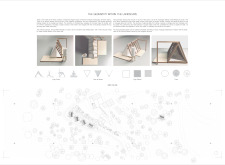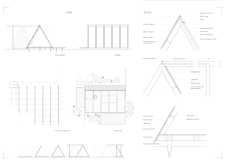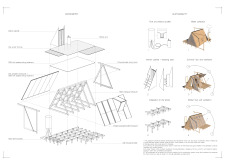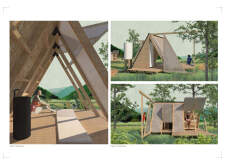5 key facts about this project
The architectural strategy employed throughout the project emphasizes thoughtful spatial organization and connectivity. Upon entering the building, one is immediately struck by the open layout that facilitates natural movement and interaction. Key areas such as communal gathering zones and private spaces are seamlessly integrated, allowing for a versatile use of the interiors. The design prioritizes accessibility, ensuring that all users can navigate the space comfortably and confidently.
Materials play a crucial role in the project’s identity, with a careful selection that enhances both sustainability and aesthetics. Concrete is used prominently for structural elements, allowing for durability and a modern feel. Large expanses of glass are strategically placed, inviting natural light to permeate the space and blurring the boundaries between the interior and exterior. This connection to the outdoors is enhanced through the use of wood accents, which add warmth and a tactile quality to the environment. Steel complements these choices, providing a robust framework while contributing to a clean, minimalist aesthetic.
Unique design approaches inform various aspects of the project, particularly in its relationship with the surrounding landscape. Outdoor spaces are thoughtfully incorporated, including terraces and gardens that extend the functional boundaries of the interior spaces. These elements not only provide additional areas for social interaction but also promote a sense of well-being among occupants by fostering a strong connection to nature. The design takes into consideration local climate patterns, utilizing passive design strategies that enhance energy efficiency and occupant comfort throughout different seasons.
The project's emphasis on sustainability is evident in its use of eco-friendly materials and energy-efficient systems. The architectural design incorporates green technologies that reduce the overall environmental footprint, reflecting a commitment to responsible architecture. Rainwater harvesting systems and solar panels may be integrated into the design, supporting a holistic approach to resource management.
Architectural details throughout the project further enhance its functionality and aesthetic coherence. Custom fixtures and finishes demonstrate a meticulous attention to detail that elevates the user experience without overshadowing the overall design intent. Consideration of lighting elements creates a dynamic atmosphere, transforming the spaces from day to night through layered lighting strategies that highlight architectural features while ensuring practical illumination.
Through its careful attention to form, materials, and environmental context, this architectural project illustrates a balanced approach to contemporary design challenges. Its multifunctional spaces and community-oriented design respond to the needs of its users, creating a vibrant hub for social interaction and development. As you explore the project presentation, you will find a wealth of information regarding architectural plans, architectural sections, and architectural designs that provide deeper insights into the innovative ideas that shaped this project. Discover the nuances of this architectural endeavor and see how it brings together form, purpose, and sustainable practices in a cohesive manner.


























